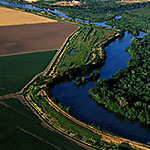Here is an Associated Press Story that may cause alarm to folks on the Delta. The latest trawl-net survey of the estuary, conducted each fall since 1967, show a drop in Delta Species. This is bad news for all residents of the Delta which includes striped bass and delta smelt. The gains from 2011 appear to be lost.
AP Story
SACRAMENTO — The latest trawl-net fish count shows the population of California’s six species of Sacramento-San Joaquin Delta fish are dwindling.
A population crash started in 2002 for the six species, including the protected Delta smelt. A wet winter in 2011 halted the decline.
But the Sacramento Bee (http://bit.ly/ZAKaNV ) says the California Department of Fish and Wildlife count in fall 2012 shows those gains have been erased.
All six species returned to their prior low numbers. One species, threadfin shad, set a record low population in the latest survey.
The Delta fish population is considered an important barometer of estuary health.
Sacramento Bee Story:
While the AP story was brief, the Sacramento Bee had a much more detailed article which can be found here
Counts drop for all six imperiled Sacramento-San Joaquin Delta fish species in latest survey
What was interesting was after cruising the comments section, Dan Bacher posted the following comment:
This article fails to point out that this fishery collapse was predicted and was avoidable. Thomas Cannon, fishery biologist, predicted the low abundance of Delta fish species during his power point presentation before the State Water Resources Control Board.
“I told the State Water Resources Control Board that the numbers in the 2012 fall survey would be really bad because of the Vise on the Delta, caused by increasing exports, increasing inflows and declining outflows,” said Thomas Cannon, fishery biologist. (http://www.waterboards.ca.gov/…
Conditions similar to this spurred the Pelagic Organism Decline (POD) of Delta smelt, longfin smelt, striped bass and other species that state and federal scientists documented first in 2005. The scientists pinpointed three major factors for the unprecedented decline (1) water export increases and changes; (2) toxic chemicals; and (3) invasive species. They later added ammonia discharges as a factor in the collapse.
Cannnon said the “vise” of increasing exports, increasing inflows from upstream reservoirs and declining outflows results in less residency time of water in the Delta. The habitat that all of the pelagic fish studied thrive in is “green water” – water that has had a chance to stay in the Delta long enough for it acquire a greenish hue because of the abundance of phyto plankton, according to Cannon. This plankton serves as the basis for the food chain that Delta smelt, threadfin shad and the other fish species thrive in.
“If water exports take all of the Delta water and the water is replaced with water from upstream reservoirs, the water doesn’t have a chance to ‘stew’ with plankton,” said Cannon. “The warm water coming downstream during the summer is lethal to the smelt. The cooler Delta water that smelt need water replaced with warm reservoir water, making conditions doubly bad for smelt.”
To avoid these fish population crashes from happening in the future, Cannon recommended that the Water Board develop specific standards for inflows, outflows and exports on the Delta, according to year type.


1 comment
More nonsense to get tighter regulations in place. This has politics all over it instead of real facts and figures.
Comments are closed.